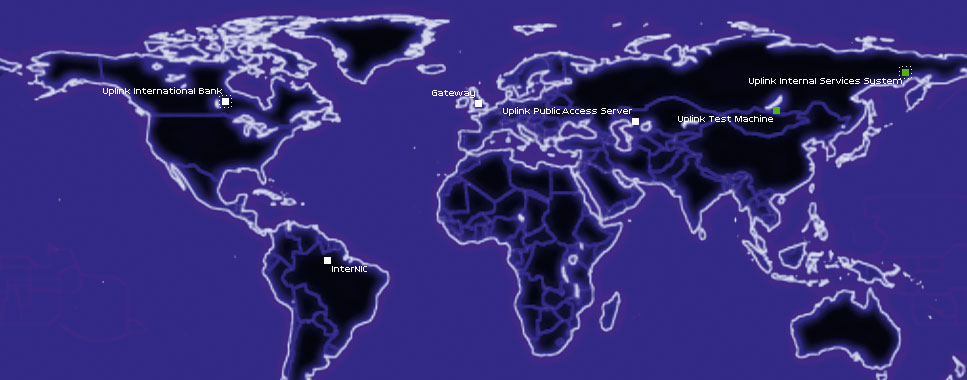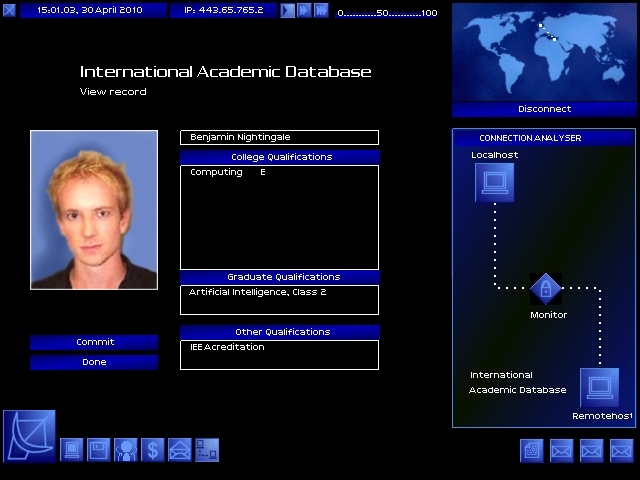Hacking in Uplink

In Why I Love, PC Gamer writers pick an aspect of PC gaming that they love and write about why it's brilliant. Today, Phil explains why Uplink is the best depiction of hacking in gaming.
Films and TV shows have a patchy history when it comes to the accurate depiction of technology and computing. It's hard not to feel let down when a film like Inside Man uses invented over-the-top violence to prey on the worst assumptions of the gaming illiterate. It's hard not to roll your eyes when admittedly dumb shows spout streams of nonsense, safe in the knowledge that many viewers won't know any better. And that's just games. The more specialist the technical knowledge needed to understand a thing, the dumber its on-screen depiction seems. For instance, hacking.
But unrealistic depictions can be fun, too. Take the film Hackers, which I fully and unironically love. It's dumb, but in a way that lets everyone be in on the joke. It doesn't sneer like Swordfish; it celebrates. It invents a world of 3D operating systems and neon punks, and then works hard to make you want to be in that world. It helps that it was set in the '90s, and everything in the '90s was already ridiculous.
Uplink—the first game from Introversion Studios—creates a similar fantasy. You’re a freelance hacker using a dial-up modem and an remote 8 gigaquad computer to work for a global organisation dedicated to cybercrime. To do so, you create long networks of connections and run various programs to break into a target server. It's absurd, but taps into the same feelings of excitement and subversiveness that are reason filmmakers keep unrealistically depicting hacking in the first place.
At their core these films are stories of a single person able to stand-up to and destroy an entire corporation. That same idea is at the heart of Uplink’s campaign. It starts off small, asking you break into servers to delete specific files, but soon ramps up in scope. Once your skill rating is high enough you’ll destroy research servers, track down rival hackers and frame innocent people for high-tech crimes. It all builds to a gloriously over-the-top technophobic finale, in which you're given the power to save or destroy the entire internet—Tumblr and all.
Uplink is great because it gets every aspect of this fantasy right. It's a tense sandbox of tools and possibilities that rewards initiative and punishes mistakes. It's a peerless lesson in how to make a game about hacking, and one I wish every maker of a hacking mini-game would learn from. Yes, it's unfair to expect a small section of an RPG or immersive sim to be as good as a game dedicated solely to hacking. I'm not saying these mini-games should have the same depth as Uplink, but there are some basic lessons that could be learned.

The most important lesson: tension. Too many hacking mini-games treat the hacking as a separate entity that's removed from the world of the game. Hack a shop in Bioshock, and the world stays frozen in place as you piss about with some pipe pieces. Break into one of Fallout 3's computers, and people politely wait as you play a word-based guessing game. This is pointless: hacking shouldn't be about the act, but the tension between the act and getting caught in it. (This applies to lockpicking, too. Automatic real-time lockpicking is inherently more tense than a convoluted mini-game in which the outside world ceases to exist.)
In Uplink, the tension is brilliantly realised through one of the game's most basic programs: the Trace Tracker. It emits beeps that mark the time remaining before a security system finds you. It starts out slowly, but as your window of opportunity diminishes it may as well double for a heart-rate monitor. The ramp up in tension it creates as you race to finish your objective in time is almost unbearable. Disconnecting with seconds to spare feels amazing.
The biggest gaming news, reviews and hardware deals
Keep up to date with the most important stories and the best deals, as picked by the PC Gamer team.
Uplink's other stroke of genius is that it makes you click on and type things manually. It's such a basic idea: forcing you to use the real-world tools of mouse and keyboard, thus creating a difficulty curve that's directly based on how much pressure you're under. To break into a system, you have to juggle programs like the agonisingly slow password breaker, firewall bypasser, vocal analyser, proxy disabler and log deleter. That done, you still have to perform the task you've been hired for, whether it's typing in search queries or editing records. It's a race, and you'll only win if you perform every action to perfection.
That's what so many games get wrong about hacking. It needn't be complex, just frantic and demanding. Uplink has plenty of depth to its content, but the hacking systems themselves are relatively simple. You execute programs and perform actions. You manage your computer and search for information. You watch the timer and, at the last possible second, cut the connection. It's these basic actions, and the tension that bubbles under them, that makes Uplink the best example of silly sci-fi game hacking.

Phil has been writing for PC Gamer for nearly a decade, starting out as a freelance writer covering everything from free games to MMOs. He eventually joined full-time as a news writer, before moving to the magazine to review immersive sims, RPGs and Hitman games. Now he leads PC Gamer's UK team, but still sometimes finds the time to write about his ongoing obsessions with Destiny 2, GTA Online and Apex Legends. When he's not levelling up battle passes, he's checking out the latest tactics game or dipping back into Guild Wars 2. He's largely responsible for the whole Tub Geralt thing, but still isn't sorry.

